![]()
- History of development INDEX >>>
- Chronicle >>>
- Our Pride >>>
- Development story vol.1 >>>
- Development story vol.2 >>>
- Development story vol.3 >>>
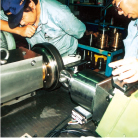 |
In the 1980’s, along with rise in exports thanks to the yen appreciation, the auto industry was just entered upon the internationalization era. The more production volume increased, the higher piston rings, core parts of engines, were required both in precision and quality. However, CNC had not yet been applied to special-purpose machines. By that time, CNC general-purpose machines had been prevailed. KATAOKA, started as a general-purpose machine manufacturer, was manufacturing general-purpose machines with CNC function as a matter of course. Having accumulated the developing techniques for CNC in such history, KATAOKA took it imperative to develop CNC also for special-purpose machines for piston rings. We proposed a technical innovation for developing CNC special-purpose machines to some piston-ring manufacturer. However, at a large risk, including cost increase, that manufacturer was not willing to cooperate with us, and the entire industry was also hesitant about such innovation. However, NC special-purpose machines for piston rings had a problem. It was a subtle difference in hydraulic pressure due to temperature change according to weather and time zone, which affected feed rate and speed. If CNC is introduced, it can set numerical values minutely, and therefore can make quality and production volume uniform and stable without being affected by change in hydraulic pressure due to temperature change. Also considering easier production control, it was already a must to develop a CNC special-purpose machine for piston rings. Setting its mind on paving a new path by developing such CNC machine, KATAOKA persuaded the piston-ring manufacturer. Approaching from the viewpoint of cost, we succeeded in developing a CNC special-purpose machine for piston rings, and began to start its manufacturing to orders. |
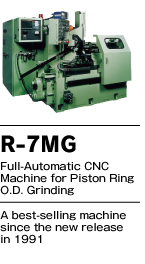 |
It was just the time when there was a growing interest in energy saving and environmental problems. Vital issues for parts manufacturers were the improvement of function and quality and the reduction of cost. KATAOKA was asked to develop special-purpose machines that could meet such needs of the times. In order to realize engines featured by low fuel consumption, high durability and highly clean exhaust gas, piston rings should be processed to more complicated shapes. Simple shapes can be ground with a single wheel, but complicated shapes cannot be processed at a time. However, if the process is divided, the processing requires more than one machine. It’s an obvious absurdity. A solution occurred to KATAOKA. “Set two wheels on one machine. Grind the work to the first shape with the first wheel. Upon grinding, shift the first wheel head sideways. Then, grind the work to the remaining shape with the second wheel.” As programmed by CNC, one machine shifts the wheels for sequential processing. It was a marvelous idea. This is how the Full-Automatic CNC Machine for Piston Ring O.D. Grinding “R-7MG” was born based on the technology and know-how that we had cultivated and accumulated during the development of special-purpose machines for piston rings starting from the manufacturing of general-purpose machines. The “R-7MG” is excellent in operation efficiency and investment effect. Since the new release in 1991, this machine has been best-selling. |
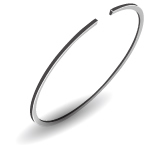 |
When the high performance of “R-7MG” equipped with CNC was being spread across the industry, a production engineer of some domestic piston-ring manufacturer approached KATAOKA with a proposal: “When an oval piston ring is processed, both the outside diameter and the inside diameter are processed in the initial process. Can CNC be applied to this process?” Mechanical control type machines manufactured by German and Swiss manufacturers had been prevailed for a long time. According to them, a model ring was set on a machine. Then, profiling the model ring as to the movement of the revolving axis, the curvature and the revolution rate, the work is ground in the parallel movement with the model ring to process the work to the same shape. However, the ring curvature is extremely delicate. Unlike the processing of a true-circle ring by constantly applying a wheel to the ring, the processing of the oval ring may result in displacement depending on how the central axis is rotated. In order to obtain uniform quality, it’s essential to make an adjustment with micron accuracy. Furthermore, each time a new order comes in, a model with a new curvature has to be made and replace the previous model. Until the model itself is finished to the satisfaction of the customer, it has to be one trial and error after another. From early on, the “necessity of developing a CNC machine for oval rings” had been discussed at KATAOKA aiming at higher production efficiency, though it was not easy to control the movement of the revolving axis and the wheel speed according to the curvature of the oval ring. In order to develop CNC software for oval-ring machines, KATAOKA’s professional engineers examined the matter from various angles. KATAOKA developed the software after repeating numerous amendments and calculations. In six months, overcoming the difficulties, KATAOKA succeeded in putting the development into the Semi-Automatic CNC Combined Machine for O.D. & I.D. Cam Turning & Gap Milling of Piston Rings DCM-1.” |
 |
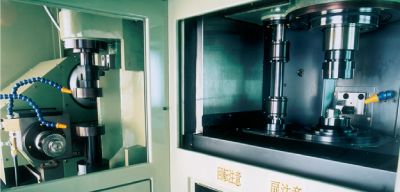 |
|
“DCM-1” has combined two processes. One is oval processing for the inside diameter and the outside diameters, respectively, and the other is processing the gap by milling. The advent of this machine has made it easy to change programming due to the ring change. To add, it has substantially cut down the process time. Now, the numerical values of customers’ specification can be satisfied precisely and speedy. Then, KATAOKA developed “DCM-1A.” It’s “DCM-1” but mounted with a robot system. Once the machine is set up, a ring of the same model can be processed continuously for a long time. Some ring manufacture says, “There are rings of curvatures that can’t be processed but on DCM.” This proves how high the preciseness and functionality of the “DCM” Series are evaluated. The technical innovation of KATAOKA, i.e., the development of CNC machines, has realized the high product quality and the short lead time. It has created value-added not only for ring manufacturers but also for users. The development of “DCM-1” started in response to the request for the same or lower cost as or than the costs of mechanically controlled machines made in Germany and Switzerland. As the competition is going global and severe at the auto industry, engine parts manufacturers are working hard to improve the quality and productivity while controlling the costs. Along with the current trend of the times, KATAOKA is aiming to develop special-purpose machines with higher cost performance. |



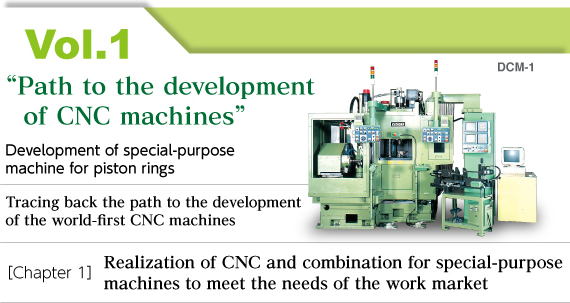

![“Path to the development of CNC machines”[Chapter 1]](img/story_side_bn01.jpg)
![“Path to the development of CNC machines”[Chapter 2]](img/story_side_bn02.jpg)



